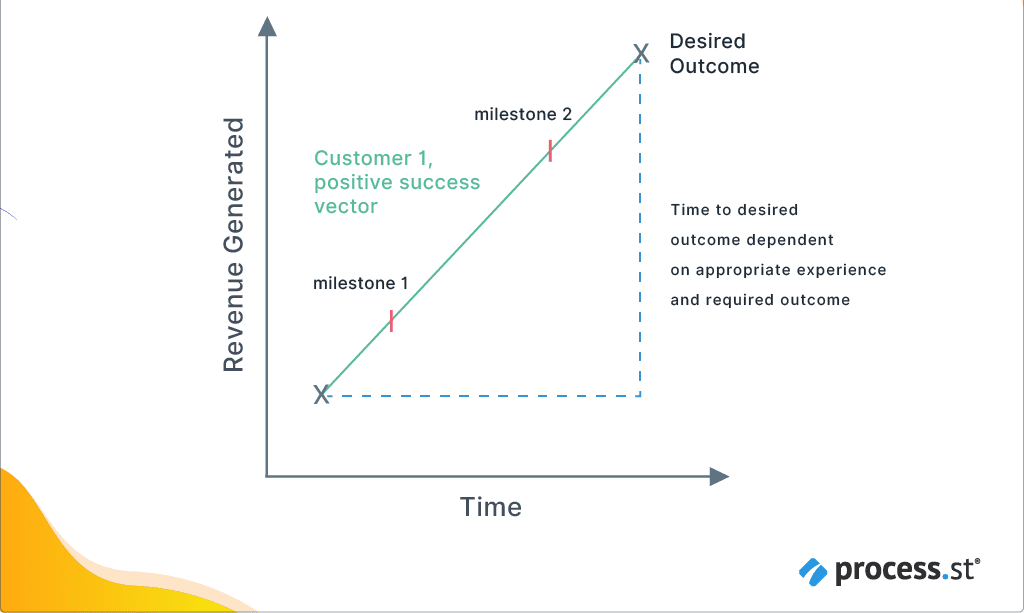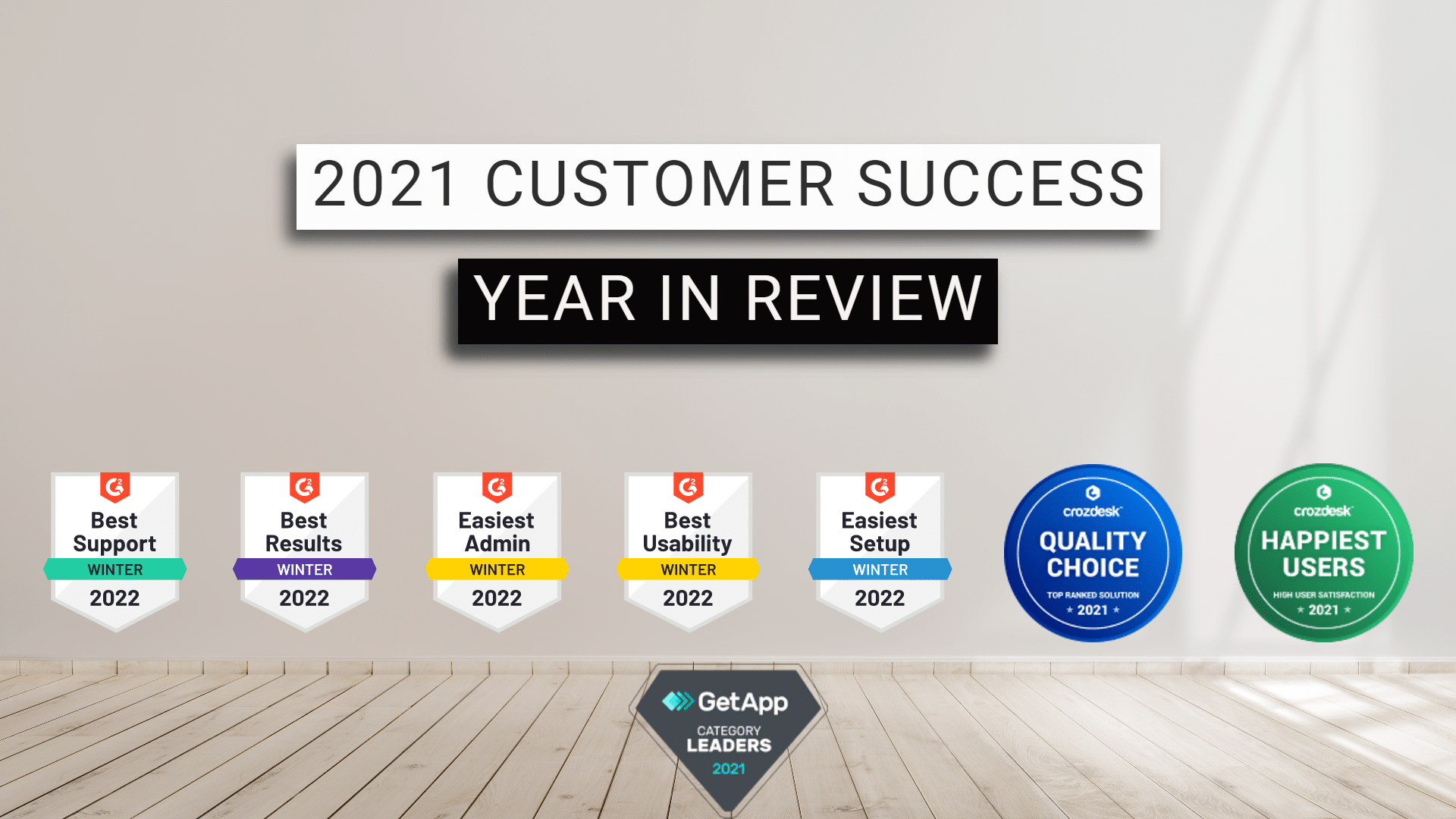79% of marketers focus their customer experience strategies on churn reduction and retention. Yet, according to McKinsey and Company, this approach isn’t ideal.
Focusing solely on churn reduction does not consider your business outcomes and how these outcomes affect and are related to the customer.
Your customer success strategies need to be tailored around what your customer wants to achieve from using your product/service. And to do this, you need to use customer success vectors.
These vectors tell you where your customers are heading compared to where they want to go/their goals for using your product/service. In this article, you’ll find out how to implement customer success vectors to improve the customer experience you deliver.
What is a customer success vector? How to apply the concept of vectors to customer success
A vector is a measurement that has both magnitude and direction.
For instance, let’s say you move three steps forward and one step to the left. You could denote this movement using the vector (3, 1).
If you moved in the opposite direction, 3 steps backward and one step to the right, then your movement would be denoted as the negative vector (-3, -1).
Vectors are often abbreviated using algebra. For instance, vector (3,1) = V, and vector (-3, -1) = -V.
As vectors describe a movement, they are visual measures, and usually mapped on a graph (as shown below). Vectors are often used to represent physical quantities such as acceleration, velocity, and displacement. How are they then useful in the world of customer success?
What is a customer success vector and how is it different from a KPI?
Applying vectors to customer success tells you where your customers are heading. Breaking the concept down, we can summarize the following:
- Direction: What does your customer need to achieve? Where is your customer going? Where is your customer relative to their goals?
- Magnitude: How will your customer achieve their goals? What does the customer have to do to achieve their goals? What experience will your customer have with your product/service? Aka, what is the magnitude of work to be done to get your customer from where they are to where they want to be?
Customer success KPI metrics – e.g. NPS score, CSAT scores, churn and customer health scoring – are in-the-moment snapshot measures. KPI metrics don’t detail where a customer is heading, and what the customer wants to achieve.
For instance, two customers may have the same customer health score measures. This suggests that right now they are using your product/service and you have strong B2B relations. However, these two customers may have different goals.
The sole use of KPI metrics will not indicate these differing goals. Applying the same customer success strategy for both customers will not take your customers to where they need to be. This isn’t conducive to customer success.
A customer success vector, however, gives a more holistic approach to customer success and cultivates a customer’s maturing use of your product/service. The aim is to strategize to propel your customers forwards towards their goals – and an improved bottom-line comes as a byproduct.
Breaking down the customer success vector into its constituent elements
Desired outcome (success vector) = Required outcome + appropriate experience
Where are your customers heading? This is the vector direction and is termed your customer’s desired outcome.
This desired outcome incorporates what the customer wants to achieve, and the experience they want while achieving this. That is the required outcome and the appropriate experience respectively.
The required outcome and the appropriate experience influence the magnitude of work to be done that will get your customers to their goal (desired outcome).
- Required outcome: What your customer needs to achieve.
- Appropriate experience: How your customer will achieve this.
Understanding the appropriate experience
The appropriate experience is what the customer takes away from using your product/service. For instance, what emotions were evoked? How does your product/service delivery make your customers feel? Were your customers satisfied? What did your customers have to do to reach their goal?
As an example, let’s say you jumped on a flight from New York to Amsterdam. Your required outcome is to reach your destination – Amsterdam. Your appropriate experience would be how you felt on this flight, and what you had to do to make sure you reached your destination – e.g. turn up on time.
You might come off your flight feeling frazzled due to limited legroom and uncomfy seats. You reached your required outcome (Amsterdam), but how you got there wasn’t the way you desired. This poor appropriate experience has pushed you away from your success vector and prevented you from reaching your desired outcome – to reach Amsterdam but feeling refreshed.
It’s under the appropriate experience where your customer success metrics come in handy. For instance, you can use NPS scoring, CSAT scoring, and customer health scores to determine whether your customers are happy using your product/service. Gather customer feedback and determine their appropriate experience.
Understanding the required outcome
The required outcome is what your customers want to achieve.
You need to determine whether your customer is on track to reach their required outcome, and for that, you need to decipher your customer’s success potential and key milestones.
Make sure your customer has success potential
For you to even consider assigning a success vector to a customer, the customer must have the ability to get to their required outcome using your product/service. This means checking off the following criteria:
- Technical fit: Refers to the technical abilities, skills, and experience of your customer. I.e. is it technically possible for your customer to meet their desired outcome? Are they using, or don’t have/won’t have the needed technology?
- Functional fit: Is your product/service missing a key piece of functionality for your customer?
- Resource fit: Are your accounts able to invest – beyond paying a fee – in what’s required to be a successful customer?
- Competence fit: Do your customers have or will they acquire the expertise internally needed to be successful?
- Cultural fit: Does your customer have complementary beliefs, morals, and attitudes to establish strong B2B relations?
Determine your customer’s success milestones
Map logical upsell or advocacy opportunities associated with your customer’s progress towards their goals as success milestones.
A success milestone might be the customer signing up for a free trial, or a customer upgrading to a premium version of your service.
Make sure the success milestones you map align with the customer’s required outcome. For instance, if upgrading to a premium version of your service does not align with a customer’s required outcome, then this would not be an appropriate success milestone.
How to visualize your customer success vectors
As mentioned at the beginning of this article, vectors are visual. Visualizing your vectors helps you understand them, but how would you go about doing this?
First off, you need to understand that your customer success vectors will fall under one of four categories:
- Positive success vectors: These accounts are progressing towards their desired outcome. They’ll meet the success potential criteria, and the customers are satisfied with the experience they have with you. Meeting the required outcome with a solid appropriate experience pushes these accounts towards their desired outcome.
- Neutral success vectors: These accounts have stalled or stagnated. You’ll need to get these accounts back on track towards their desired outcome. Look at their appropriate experience – how can this be improved? Are these accounts hitting their success milestones?
- Negative success vectors: These accounts are not on the right track and require urgent intervention. They are withdrawing their use from you and traveling backward from their desired outcome.
- Ghost vectors: These accounts are highly likely to churn. Your key contacts have stopped engaging. We’re moving outside the realms of customer success, and you need to be thinking about strategies that will prevent churn. Be sure to audit these accounts to see if they’re worth the time and effort to keep.
Vectors are usually visualized using a graph. To represent your customer success vectors on a graph you’ll need:
- X-axis: A variable that measures magnitude.
- Y-axis: A variable that captures the desired outcome – where the customer wants to go.
For instance, let’s say we use time on the X-axis. Time will capture the amount of work to be done to take customers from point A to point B (their desired outcome). A low-appropriate experience will demand more work to satisfy the customer, hence the vector magnitude will be greater.
On the Y-axis we could have revenue. The customer’s desired outcome will be associated with a specific revenue. You’re encouraging your customer to grow with you, to meet their goals by using your product/service. This inherently leads to upsell/advocacy opportunities, and hence a revenue boost. Point A will be at a lower revenue than point B (your customer’s desired outcome).
The vector described has been drawn below.

Customer success vectors in action (applying the theory)
ALS Environmental is a laboratory that tests environmental samples for pollutants. Their customer success team is charged with handling technical requests given by clients, and it’s the CS team’s job to make sure these clients reach their goals using the testing service provided.
How does ALS do this?
Let’s consider two of ALS’s top clients to understand how.
- Client one: Is a waste, water, and energy management organization, helping businesses reduce their environmental impact through infrastructure investments and waste removal. Client one had a high customer health score due to ongoing project expansion, and a high input of samples to be tested by the laboratory.
- Client two: Is an environmental consultancy, focused on providing accurate information to a large set of businesses regarding their environmental performance. They used the laboratory as a middle-man resource, to test samples given to them by their clients. Client two had a high customer health score due to the high input of samples to be tested and solid support statistics (e.g. CSAT and NPS).
The two clients had equal customer health score measures, yet they were dramatically different in terms of how the laboratory could assist them in meeting their growth goals. This difference was due to different maturities, e.g. where the clients were relative to where they were going, as explained below.
- Client 1: Was a business of many parts (water, waste, and energy management). Their goal was to continue to expand and consolidate the environmental services they provided using different business units. ALS’s CS strategy was to stress the different testing features to the relevant business unit. Some needed only basic sample testing, whereas other units were further along regarding their relationship with us, and had complex testing quotas to meet.
- Client 2: Operated from a single office, with a strong team of environmental consultants with a high technical know-how. Their aim was to provide increasingly complex and accurate analyses for their clients.
“Helping Customer 2 succeed and grow with us as a laboratory needed careful relationship management, addressing ever-increasing demands. We regularly visited Customer 2 on-site and produced joint Quarterly Business Reviews (QBRs). These reviews focused on numerically quantifying past results, as well as facilitating deep discussions about testing and service expansion.” – Jane Courtnell, 5 Tips to Make Your Customer Success Vectors Actual Vectors (KSIs Not KPIs)
Client 1 and client 2 were heading in different directions. They had different capabilities, meaning how they were going to achieve their desired outcome using ALS also differed. This clear distinction would be lost with a single KPI measure (customer health score). Yet, if equal CS strategies were applied to client 1 as per client 2, client 1 would not achieve their goals (and vice versa). Customer success vectors captured this information for different CS strategies to be applied.
Your customer success team is the growth engine of your business. With snapshot KPI metrics, you’re running blind. You have little information on how your customer is progressing with you. Customer success vectors shed light on a customer’s progress with your brand. Success vectors are measures that allow you to work with your customers, taking them to where they need to be and aligning your customer success initiatives with your business outcomes.




